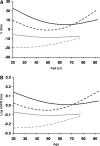Relative performance of the MDRD and CKD-EPI equations for estimating glomerular filtration rate among patients with varied clinical presentations
- PMID: 21737852
- PMCID: PMC3156428
- DOI: 10.2215/CJN.02300311
Relative performance of the MDRD and CKD-EPI equations for estimating glomerular filtration rate among patients with varied clinical presentations
Abstract
Background: The Chronic Kidney Disease Epidemiology Collaboration (CKD-EPI) equation was developed using both CKD and non-CKD patients to potentially replace the Modification of Diet in Renal Disease (MDRD) equation that was derived with only CKD patients. The objective of our study was to compare the accuracy of the MDRD and CKD-EPI equations for estimating GFR in a large group of patients having GFR measurements for diverse clinical indications.
Design, setting, participants, and measurements: A cross-sectional study was conducted of patients who underwent renal function assessment for clinical purposes by simultaneous measurements of serum creatinine and estimation of GFR using the MDRD and CKD-EPI equations and renal clearance of iothalamate (n = 5238).
Results: Bias compared with measured GFR (mGFR) varied for each equation depending on clinical presentation. The CKD-EPI equation demonstrated less bias than the MDRD equation in potential kidney donors (-8% versus -18%) and postnephrectomy donors (-7% versus -15%). However, the CKD-EPI equation was slightly more biased than the MDRD equation in native CKD patients (6% versus 3%), kidney recipients (8% versus 1%), and other organ recipients (9% versus 3%). Among potential kidney donors, the CKD-EPI equation had higher specificity than the MDRD equation for detecting an mGFR <60 ml/min per 1.73 m(2) (98% versus 94%) but lower sensitivity (50% versus 70%).
Conclusions: Clinical presentation influences the estimation of GFR from serum creatinine, and neither the CKD-EPI nor MDRD equation account for this. Use of the CKD-EPI equation misclassifies fewer low-risk patients as having reduced mGFR, although it is also less sensitive for detecting mGFR below specific threshold values used to define CKD stages.
Figures


Comment in
-
Measured GFR as "gold standard"--all that glitters is not gold?Clin J Am Soc Nephrol. 2011 Aug;6(8):1813-4. doi: 10.2215/CJN.06040611. Epub 2011 Jul 22. Clin J Am Soc Nephrol. 2011. PMID: 21784836 No abstract available.
References
-
- Bertolatus JA, Goddard L: Evaluation of renal function in potential living kidney donors. Transplantation 71: 256–260, 2001 - PubMed
-
- Lin J, Knight EL, Hogan ML, Singh AK: A comparison of prediction equations for estimating glomerular filtration rate in adults without kidney disease. J Am Soc Nephrol 14: 2573–2580, 2003 - PubMed
-
- Pierrat A, Gravier E, Saunders C, Caira MV, Ait-Djafer Z, Legras B, Mallie JP: Predicting GFR in children and adults: A comparison of the Cockcroft-Gault, Schwartz, and modification of diet in renal disease formulas. Kidney Int 64: 1425–1436, 2003 - PubMed
-
- Rule AD, Gussak HM, Pond GR, Bergstralh EJ, Stegall MD, Cosio FG, Larson TS: Measured and estimated GFR in healthy potential kidney donors. Am J Kidney Dis 43: 112–119, 2004 - PubMed
-
- Vervoort G, Willems HL, Wetzels JF: Assessment of glomerular filtration rate in healthy subjects and normoalbuminuric diabetic patients: Validity of a new (MDRD) prediction equation. Nephrol Dial Transplant 17: 1909–1913, 2002 - PubMed
Publication types
MeSH terms
Substances
Grants and funding
LinkOut - more resources
Full Text Sources
Other Literature Sources
Medical

